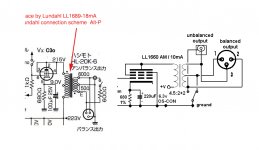I am researching transformer-coupled outputs as I might try to build a microphone preamp stealing ideas from phono pres etc... I am looking at these very similar designs and I am puzzled by the center of the secondary going to ground. What i saw in the usual cap coupled output mic pre is that the winding ends make the signal leads and the ground is taken from the chassis.
Thanks...
Thanks...
Attachments
Grounding the CT of a floating winding makes it "true balanced". This is almost never better in home or small studio work. It was conventional in radio network operation where conditions are different.
But why ask? Build it, use a jumper to try both ways.
But why ask? Build it, use a jumper to try both ways.
Thanks! I like to try to understand what happens in a circuit, at least a notch above just copying. Trying both way is easy but it is good to know in advance that nothing will blow 🙂
It may "stop working" if the other end of the line does not like it.
But coming out of a small tube (and external outputs generally), it should not explode or leave a mess on the carpet. If an alternate ground system makes it unhappy, don't do that again.
But coming out of a small tube (and external outputs generally), it should not explode or leave a mess on the carpet. If an alternate ground system makes it unhappy, don't do that again.
In order for a shield to work it needs to be connected. In a 3 wire balanced circuit the shield is just that a shield. But in order for it to actually work it has to be grounded, at least at one end.
In the 2 wire mode it is also the return signal and wouldn't need to be grounded, but in most cases it is.
In the 2 wire mode it is also the return signal and wouldn't need to be grounded, but in most cases it is.
- Status
- Not open for further replies.
